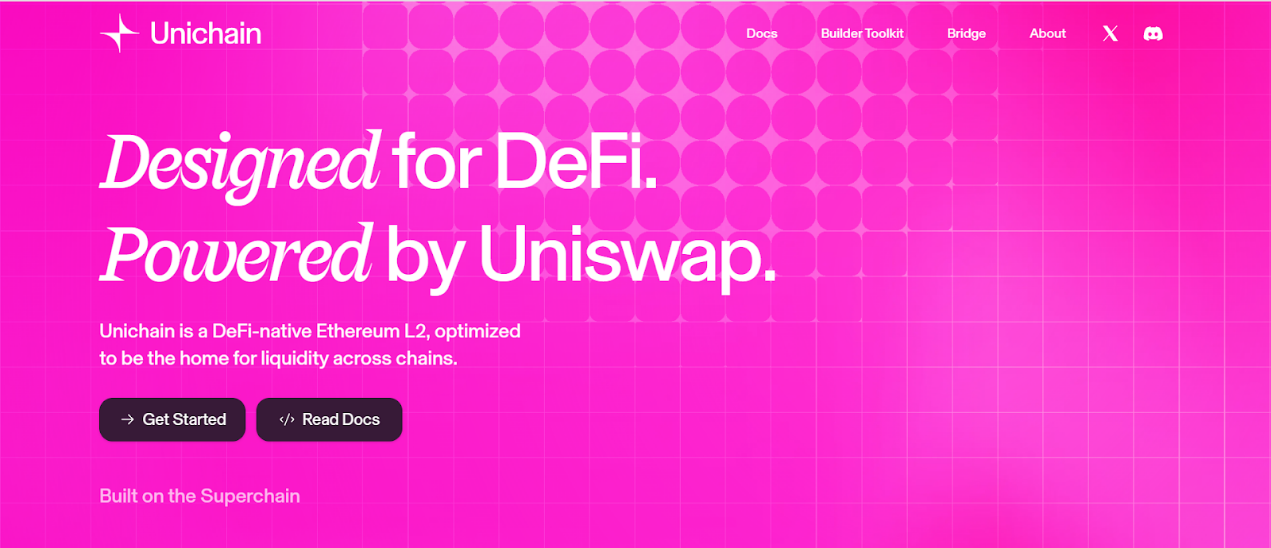Compiled by: Felix, PANews
Recently, Uniswap developer Uniswap Labs announced the launch of its own L2 network, Unichain, on Ethereum and released a white paper. The network is built on OP Stack technology and is scheduled to go live on the testnet today, with the mainnet set to launch later this year. Uniswap stated that the chain is expected to provide faster and cheaper transactions while enhancing interoperability across blockchain networks.
Unichain is being developed in collaboration with Uniswap Foundation, Optimism, and Flashbots, and will introduce several technological innovations, including a Trusted Execution Environment (TEE) for block construction and a community validation network. The TEE is expected to reduce block generation time to 200-250 milliseconds. Following this news, UNI broke through $8, with a 24-hour increase of over 12%, marking the highest level in three months.

Technical Details
Low Cost, Further Decentralization
Decentralization is the foundation of DeFi. Ethereum is highly decentralized, which requires compromises on the speed and affordability of L1 transactions. To maintain a decentralized approach to scaling Ethereum, the network began offering cheap data to L2s earlier this year as part of a rollup-centric roadmap.
Unichain aims to leverage and accelerate Ethereum's scaling roadmap by shifting execution to L2. In practice, this means that Unichain will reduce transaction costs by about 95% in the short term compared to Ethereum L1, with even greater reductions expected in the future.
Unichain will launch a decentralized validation network that allows nodes to validate blocks. This adds an additional layer of finality and reduces the risk of conflicts or invalid blocks. The community validation network is set to launch in 2025, aiming to "help validate blocks by allowing full nodes to stake UNI," thereby aiding decentralization. To become a validator for the Unichain virtual machine, node operators must stake UNI tokens on the Ethereum mainnet.
Fast, Near-Instant Transactions
To bring the next generation of markets on-chain, DeFi needs to be faster. Currently, the Ethereum mainnet has a block time of 12 seconds, while most L2 networks have a block time of 2 seconds. Unichain's initial block time is set at 1 second, with plans to introduce "sub-blocks" that aim to reduce block time to under 250 milliseconds. Instant, faster blocks enhance market efficiency and reduce the value of MEV losses.
This improvement is achieved through a block builder developed in collaboration with Flashbots, which utilizes a Trusted Execution Environment (TEE). In addition to increasing speed, the TEE is designed to enhance the transparency of transaction ordering and prevent transaction failures.
While the TEE cannot replace decentralized consensus, it can significantly enhance trust and security compared to other block builders.
Seamless Multi-Chain Transactions
As Ethereum's scaling roadmap is realized, many L2s will emerge. While new L2s help reduce costs, they also fragment liquidity and create a poor user experience. The construction of Unichain is aimed at achieving seamless access to transactions, regardless of which chain users are on.
As part of the Optimism Superchain, Unichain is collaborating with OP Labs to achieve native interoperability, which will enable single-block cross-chain messaging between Superchain L2s. The Superchain is a network of interoperable L2 scaling solutions built using the Optimism tech stack. Other Superchain networks include Base and SNAXchain, the latter managing Synthetix's decentralized perpetual exchange. For chains outside the Superchain, Unichain plans to enhance interoperability between all chains through initiatives like ERC-7683.
When users have a simple, intuitive interface to access cross-chain liquidity, a greater impact will be realized. Shortly after the launch of Unichain, cross-chain trading will be introduced in the Uniswap interface and Uniswap wallet.
Currently, Uniswap has chosen Pyth Network to provide real-time data for Unichain. Pyth Network's 500+ real-time price feeds and low-latency data are updated every 400 milliseconds, ensuring that Unichain developers have real-time access to DeFi data.
Is it Still Meaningful for Unichain to Join Late?
Although the launch of Unichain has garnered some market attention and boosted the performance of the UNI token, the past year has seen a surge of L2 solutions in the crypto industry, leading market experts to believe this has resulted in network fragmentation. However, Uniswap Labs CEO Hayden Adams explained the importance of multiple L2 chains for Ethereum's scaling, stating that "the value internet cannot operate on a single chain."
But not everyone is in agreement. Vitalik expressed in September 2022 that he did not understand the significance of Uniswap creating its own chain. He believes that Uniswap's core value lies in users being able to complete transactions quickly, and that the Uniswap chain or Rollup does not provide additional advantages in this regard. It makes more sense to replicate Uniswap's model on each Rollup, as cross-chain bridging has inherent friction and time delays that cannot be fully abstracted. Additionally, wealthy users can leverage automation tools to split transactions across multiple Rollups to reduce slippage risk.
Related article: Uniswap launches L2 chain, is UNI finally set to break out of the "governance token dilemma"?
免责声明:本文章仅代表作者个人观点,不代表本平台的立场和观点。本文章仅供信息分享,不构成对任何人的任何投资建议。用户与作者之间的任何争议,与本平台无关。如网页中刊载的文章或图片涉及侵权,请提供相关的权利证明和身份证明发送邮件到support@aicoin.com,本平台相关工作人员将会进行核查。




